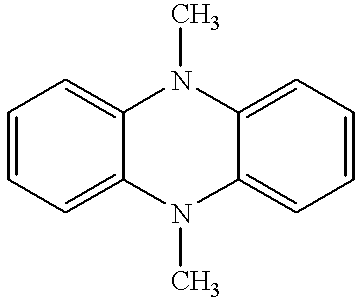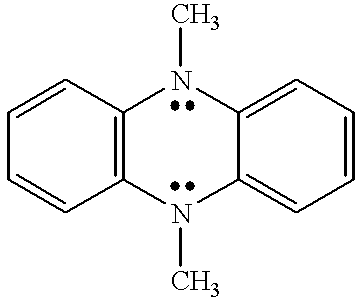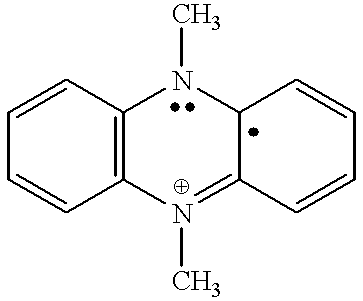Coupled electrochromic compounds with photostable dication oxidation states
a technology of electrochromic compounds and dication, applied in the field of coupling electrochromic compounds with photostable dication oxidation states, can solve the problems of electrochromic devices used in these environments electrochromic devices that have not found wide acceptance, etc., to achieve the effect of enhancing photochemical stability
- Summary
- Abstract
- Description
- Claims
- Application Information
AI Technical Summary
Benefits of technology
Problems solved by technology
Method used
Image
Examples
example 2
Syntheses of 5,5',10,10'-tetramethyl-2,2'-bis[a]benzophenazine
In a 3-necked round bottom flask 7.9 g 1,2-naphthoquinone was dissolved in 100 ml acetic acid and heated to 60.degree. C. 5.0 g of 3,3'-diaminobenzidine was dissolved in 200 ml ethanol and the 100 ml acetic acid containing the naphthoquione was dripped into the benzidine solution followed by stirring at 60.degree. C. for 2.5 hours. The mixture was then cooled and the solid bisphenazine separated by filtration. Alkylation of the bisphenazine was accomplished by preparing a 3:1 mole:mole alloy of K:Na in refluxing toluene. After the mixture cooled, the toluene was removed, and dimethoxyethane added. The bisphenazine was added in a 1:10 mole:mole ratio with the alloy, and the mixture was allowed to stir for 2 hours at 50.degree. C. Methyl iodide was added, and the product isolated by standard techniques.
example 3
Alkylation of 5,5',10,10'-tetramethyl-2,2'-bis[b]benzophenazine
2,2'-bis[b]benzophenazine was prepared analogously to the benzo[a]phenazine of Example 2. Alkylation of the bisphenazine was accomplished by preparing a 3:1 mole:mole alloy of K:Na in refluxing toluene. After the mixture cooled, the toluene was removed, and dimethoxyethane added. The bisphenazine was added in a 1:10 mole:mole ratio with the alloy and the mixture was allowed to stir for 2 hours at 50.degree. C. Methyl iodide was added, and the product subsequently isolated.
example 4
Syntheses of 5,5',10,10'-tetramethyl-2,2'-bis[a,c]benzophenazine
11.5 g phenanthroquinone was dissolved in 400 ml acetic acid and heated to 105.degree. C. 5.4 g of 3,3'-diaminobenzidine was dissolved in 200 ml ethanol and the 400 ml acetic acid containing phenanthraquinone was dripped into the benzidine solution, and was stirred at 100.degree. C. for 1 hour. The mixture was then cooled, and the solid bisphenazine separated by filtration. Alkylation of the bisphenazine was accomplished by forming a 3:1 mole:mole alloy of K:Na in refluxing toluene. After the mixture cooled, the toluene was removed, and dimethoxyethane added. The bisphenazine was added in a 1:10 mole:mole ratio with the alloy, and the mixture allowed to stir for 2 hours at 50.degree. C. Methyl iodide was added and the product isolated.
PUM
| Property | Measurement | Unit |
|---|---|---|
| thickness | aaaaa | aaaaa |
| thickness | aaaaa | aaaaa |
| temperature | aaaaa | aaaaa |
Abstract
Description
Claims
Application Information
 Login to View More
Login to View More - R&D
- Intellectual Property
- Life Sciences
- Materials
- Tech Scout
- Unparalleled Data Quality
- Higher Quality Content
- 60% Fewer Hallucinations
Browse by: Latest US Patents, China's latest patents, Technical Efficacy Thesaurus, Application Domain, Technology Topic, Popular Technical Reports.
© 2025 PatSnap. All rights reserved.Legal|Privacy policy|Modern Slavery Act Transparency Statement|Sitemap|About US| Contact US: help@patsnap.com



